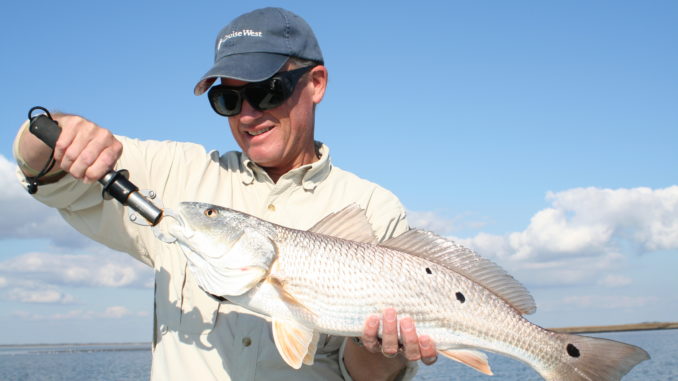
Find ‘em, see ‘em, fool ‘em and hook ‘em and Lowcountry redfish can be yours.
Redfish are easy.
Some freshwater anglers, especially those who focus on cold-water trout, disdainfully quip that “Catching bass is easy; anyone can catch one.”
It’s true, anyone can catch a black bass in freshwater, and more to the point in our Lowcountry shallows, anyone can catch a redfish — at times. When conditions are right and you find yourself near a school of spot-tail bass, throwing any bait or lure into their midst will get you hooked up.
But as professional bass anglers and tournament redfish anglers know, it’s not whether you can catch an occasional fish; the trick is being able to catch lots of fish when you want to, and that is where skill and knowledge come into play.
Four skills are necessary to consistently find and catch spottail bass in the saltwater shallows. You have to know where the fish are, generally; you have to see where the fish are, specifically; you have to know what lure or bait to place in front of them; and you have to know how to work those baits or lures to make the fish strike.
Then, assuming you hook up solidly, you’ll get to wrestle with a powerful tugging and pulling machine that most of the time you will get to the boat for a grip-and-grin photo or into your cooler for a delicious supper, unless your line breaks or your knot fails, but that’s another subject.
Where do redfish live?
In South Carolina’s Lowcountry, redfish are caught year-round. Some months it’s easier, some harder. By May, the water has warmed, bait has returned to the low-tide flats and spot-tails are feeding aggressively on finger mullet, crabs, mud minnows and various other delectables. It’s one of the easier months.
From now through the rest of the warm season, redfish are caught in normal, low-tide hotspots while they transition across oyster rakes and through the tall grass as the water rises, and also during high tides when they filter into upper portions of the smooth cordgrass and farther into the shorter grasses of hard-bottomed flats pursuing fiddler crabs.
In both summer and winter, inshore redfish spend most of there time in schools of similar-sized fish, swimming in water less than two feet deep. Redfish are homebodies, rarely venturing more than several hundred yards from their favorite spot — as attested to in tagging studies by SCDNR biologist Robert Wiggers. Data suggests that the vast majority of angler-tagged fish that are released and later caught by another angler, come from water very close to the first catch site.
Recognizing a good, low-tide flat is a key to finding fish at all stages of the tides because that home-base, low-water location provides the jumping-off place for migrations into adjacent grass lines and up into high-tide feeding locations. During his seminars, Capt. Jack Brown of Beaufort describes typical low-tide flats as holding some water even on the lowest, negative tides. If a negative tide drains a flat completely, redfish have no place to hide from their arch enemy, the bottlenose dolphin if they are forced back into a deeper channel. Furthermore, productive flats will change depth gradually; grass lines will often be in the rear portions, and oyster beds that provide sanctuary for small fishes and other critters often dot them. Frequently, a creek or tidal cut drains into the flat, and most will also have some deeper water nearby. Area guides will tell you to look for redfish near structure, points, oysters, grass banks and mud flats, but these describe virtually all the Lowcountry habitat. There is just too much good-looking water, so narrow it down by finding a good low tide flat and fish near it.
The next step is being able to find them.
By May, with their metabolism returned to normal, spot-tails are aggressively chasing the more plentiful food. That’s the good news, but the water clarity diminishes dramatically in warm water, making fish much harder to locate visually. Yes, you can catch fish from a good flat by blind-casting or floating baits, but you will catch many more if you know specifically where the fish are.
Experienced anglers can see redfish, sometimes from great distances. In reality, they don’t see the fish; they see signs in the water that tell them fish are there. Tuck Scott, head guide at Beaufort’s Bay Street Outfitters, calls one such sign “nervous water” — a surface disturbance that looks different from the surrounding water. Nervous water is often caused by random movements of something below the surface: perhaps small baitfish, larger mullet, a foraging shark, a cruising sting ray or a school of spot-tails.
If you see a fish jump in that particular area, it is probably only mullet, because redfish rarely jump. If the disturbance looks like a single, large fish swirling aggressively on something and it occurs again near the first spot, it’s probably a shark. But, if what you see what appears to be multiple fish moving randomly, you may have found pay dirt.
“Pushes” are another sight that excite anglers targeting redfish. The vernacular defines a push as the V-shaped wake, often actually more U-shaped, of one or several large fish moving through the water. Redfish pushes are different from the multiple small wakes, almost ripples, of a school of small baitfish, but the two are often confused. Wakes follow the fish so, when casting, lead the wake by several feet.
“Muds” are plumes of mud or sand that suspend as a cloud in the water rising from a spot just vacated by a redfish, which make an aggressive tail flip when spooked. When you see muds, the bad news is you have moved too close and spooked them. The good news is you have found fish. Be more careful and you may find them again nearby and get a shot at them.
On calm days with excellent visibility, sometimes you can see shadows on the bottom that appear to be grass. Other times you may see what Capt. Dave Murray, the dean of Beaufort- area fly-fishing guides, calls a “golden wink.” When spot-tails roll in shallow water they flash a glimpse of golden color from their belly and lower sides, and flashing bellies are a sure sign of catchable fish.
What lures and bait work?
Redfish are opportunity feeders and will eat almost anything, but biological research tells us that the larger ones, those between about 23 and 30 inches in length, eat mostly fish. This tidbit suggests to smart anglers what baits or lures will work best.
Probably the most popular artificial bait — and a favorite of guide Richard Sykes, is a jighead and soft-plastic Gulp! trailer. The old standby, 4-inch Bass Assassin Sea Shad in the electric chicken color is also still popular.
The consensus among guides is that spin-casters throwing bait should be lip-hooking mud minnows to a 1/4- to 3/8-ounce jighead or a small, gold Johnson spoon. When working a rising tide, mud minnows on light corks work well, and, of course, in warmer water, the extra noise of a popping cork attracts attention.
For fly fishermen, opinions vary greatly. Murray opts for castability, choosing a small red-white Lefty’s Deceiver fly. Brown, on the other hand, likes the action of Clouser-type, weighted flies that get to the bottom quickly — especially his own creation, the “electric chicken fly.” Scott likes Dupree spoon flies — the Razmataz and LC Shrimp — while Sykes uses a lightly weighted shrimp pattern. Truth be known, any of the above will catch redfish if well presented and retrieved.
Whichever bait you choose, you still need to know where to cast it and how to move it. Sykes and most guides advise anglers working fish in shallow water to cast slightly ahead of the fish and hop the bait away. But if the fish spook before your cast, an immediate cast into their midst will often produce a hookup. Brown and other guides fish their offerings slowly, keeping them in the strike zone as long as possible. Scott and others work more quickly, depending on instinct strikes. Both methods work, depending on the mood of the fish. The best anglers have their favorite methods but are flexible enough to try anything to get a strike.
In half-tide conditions, work shorelines, drifting or poling slowly along, casting at pockets and indentations along the shore, blind-casting for fish staging along the grass. A slower retrieve that bounces the bait off the bottom without getting hung up too often is the technique with lures. Cork rigs floated along the grass lines are very effective.
When casting at tailing fish on high water, lead the fish a few feet and then do not move the lure once the fish moves to it.
Lowcountry fishermen have many of options in May, and despite cobia — the “belle of the ball” — flaunting their impressive size and shape, many anglers’ attention remains on the equally attractive, albeit less voluptuous, redfish, which remains a wonderful alternative.
DESTINATION INFORMATION
HOW TO GET THERE/WHEN TO GO — Fishermen in the Hilton Head and Bluffton areas ahve good access via the Alljoy landing on the May River in old Bluffton and the Chechessee River landing at the foot of the SC 170 bridge. Fishermen in Beaufort have access at the Sam’s Point Landing on SR 802 on Lady’s Island, the Russ Landing at the Fripp Island bride and the Port Royal landing on the Beaufort River. Fish are active on all stages of the tide from May through November, but most fishermen who sight-fish for reds like low-tide flats for two hours on either side of the tide.
TACKLE/TECHNIQUES — Medium-action spinning outfits spooled with 20- to 30-pound braid and featuring an 18-inch fluorocarbon leader of a similar size are a great choice. Use jigheads with soft-plastic trailers, Johnson spoons or live bait under cork rigs. For fly-fishermen, 7- to 8-weight rods are the norm, with red/white Lefty’s Decievers, weighted Clouser’s, Dupree’s Spoon flies or any shrimp imitation all tough for reds to resist.
FISHING INFO/GUIDES — Bay Street Outfitters, Beaufort, 843-524-5250, Boat & Dock Supply in Port Royal, 843-986-0552 and Grayco Hardware on Lady’s Island, 843-521-8060 are good sources for information and tackle. Capt. Richard Sykes, 843-838-2245; Capt. Tuck Scott, 843-271-5406; and Capt. Jack Brown, 843-838-9369, are excellent light-tackle and fly fishing guides. Dave Murray, 843-525-6820, regularly presents information-packed fishing programs to groups and offers group or private fly-casting lessons.
ACCOMMODATIONS — Beaufort Area Chamber of Commerce at 843-986-5400.
MAPS — Capt. Segull’s Nautical Charts, 888-473-4855, www.captainsegullcharts.com; Top Spot waterproof map number N233, showing details on many of the local shallow water spots, is available from local tackle shops.

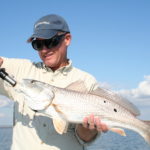
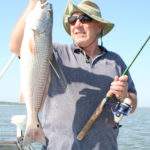
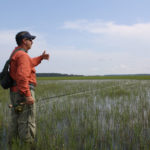
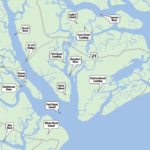


Be the first to comment